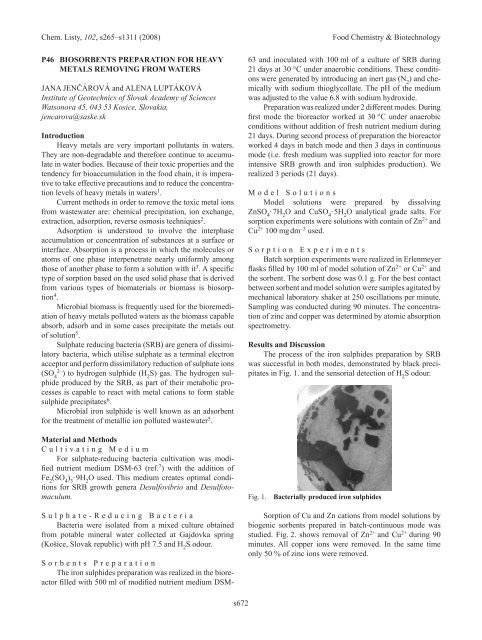3. FOOD ChEMISTRy & bIOTEChNOLOGy 3.1. Lectures
3. FOOD ChEMISTRy & bIOTEChNOLOGy 3.1. Lectures
3. FOOD ChEMISTRy & bIOTEChNOLOGy 3.1. Lectures
Create successful ePaper yourself
Turn your PDF publications into a flip-book with our unique Google optimized e-Paper software.
Chem. Listy, 102, s265–s1311 (2008) Food Chemistry & Biotechnology<br />
P46 bIOSORbENTS PREPARATION FOR hEAVy<br />
METALS REMOVING FROM wATERS<br />
JAnA JEnČáROVá and ALEnA LUPTáKOVá<br />
Institute of Geotechnics of Slovak Academy of Sciences<br />
Watsonova 45, 043 53 Kosice, Slovakia,<br />
jencarova@saske.sk<br />
Introduction<br />
Heavy metals are very important pollutants in waters.<br />
They are non-degradable and therefore continue to accumulate<br />
in water bodies. Because of their toxic properties and the<br />
tendency for bioaccumulation in the food chain, it is imperative<br />
to take effective precautions and to reduce the concentration<br />
levels of heavy metals in waters 1 .<br />
Current methods in order to remove the toxic metal ions<br />
from wastewater are: chemical precipitation, ion exchange,<br />
extraction, adsorption, reverse osmosis techniques 2 .<br />
Adsorption is understood to involve the interphase<br />
accumulation or concentration of substances at a surface or<br />
interface. Absorption is a process in which the molecules or<br />
atoms of one phase interpenetrate nearly uniformly among<br />
those of another phase to form a solution with it 3 . A specific<br />
type of sorption based on the used solid phase that is derived<br />
from various types of biomaterials or biomass is biosorption<br />
4 .<br />
Microbial biomass is frequently used for the bioremediation<br />
of heavy metals polluted waters as the biomass capable<br />
absorb, adsorb and in some cases precipitate the metals out<br />
of solution 5 .<br />
Sulphate reducing bacteria (SRB) are genera of dissimilatory<br />
bacteria, which utilise sulphate as a terminal electron<br />
acceptor and perform dissimilatory reduction of sulphate ions<br />
(SO 4 2– ) to hydrogen sulphide (H2 S) gas. The hydrogen sulphide<br />
produced by the SRB, as part of their metabolic processes<br />
is capable to react with metal cations to form stable<br />
sulphide precipitates 6 .<br />
Microbial iron sulphide is well known as an adsorbent<br />
for the treatment of metallic ion polluted wastewater 5 .<br />
Material and Methods<br />
C u l t i v a t i n g M e d i u m<br />
For sulphate-reducing bacteria cultivation was modified<br />
nutrient medium DSM-63 (ref. 7 ) with the addition of<br />
Fe 2 (SO 4 ) 3 . 9H2 O used. This medium creates optimal conditions<br />
for SRB growth genera Desulfovibrio and Desulfotomaculum.<br />
S u l p h a t e - R e d u c i n g B a c t e r i a<br />
Bacteria were isolated from a mixed culture obtained<br />
from potable mineral water collected at Gajdovka spring<br />
(Košice, Slovak republic) with pH 7.5 and H 2 S odour.<br />
S o r b e n t s P r e p a r a t i o n<br />
The iron sulphides preparation was realized in the bioreactor<br />
filled with 500 ml of modified nutrient medium DSM-<br />
s672<br />
63 and inoculated with 100 ml of a culture of SRB during<br />
21 days at 30 °C under anaerobic conditions. These conditions<br />
were generated by introducing an inert gas (n 2 ) and chemically<br />
with sodium thioglycollate. The pH of the medium<br />
was adjusted to the value 6.8 with sodium hydroxide.<br />
Preparation was realized under 2 different modes. During<br />
first mode the bioreactor worked at 30 °C under anaerobic<br />
conditions without addition of fresh nutrient medium during<br />
21 days. During second process of preparation the bioreactor<br />
worked 4 days in batch mode and then 3 days in continuous<br />
mode (i.e. fresh medium was supplied into reactor for more<br />
intensive SRB growth and iron sulphides production). We<br />
realized 3 periods (21 days).<br />
M o d e l S o l u t i o n s<br />
Model solutions were prepared by dissolving<br />
ZnSO 4 . 7H2 O and CuSO 4 . 5H2 O analytical grade salts. For<br />
sorption experiments were solutions with contain of Zn 2+ and<br />
Cu 2+ 100 mg dm –3 used.<br />
S o r p t i o n E x p e r i m e n t s<br />
Batch sorption experiments were realized in Erlenmeyer<br />
flasks filled by 100 ml of model solution of Zn 2+ or Cu 2+ and<br />
the sorbent. The sorbent dose was 0.1 g. For the best contact<br />
between sorbent and model solution were samples agitated by<br />
mechanical laboratory shaker at 250 oscillations per minute.<br />
Sampling was conducted during 90 minutes. The concentration<br />
of zinc and copper was determined by atomic absorption<br />
spectrometry.<br />
Results and Discussion<br />
The process of the iron sulphides preparation by SRB<br />
was successful in both modes, demonstrated by black precipitates<br />
in Fig. 1. and the sensorial detection of H 2 S odour.<br />
Fig. 1. bacterially produced iron sulphides<br />
Sorption of Cu and Zn cations from model solutions by<br />
biogenic sorbents prepared in batch-continuous mode was<br />
studied. Fig. 2. shows removal of Zn 2+ and Cu 2+ during 90<br />
minutes. All copper ions were removed. In the same time<br />
only 50 % of zinc ions were removed.

















